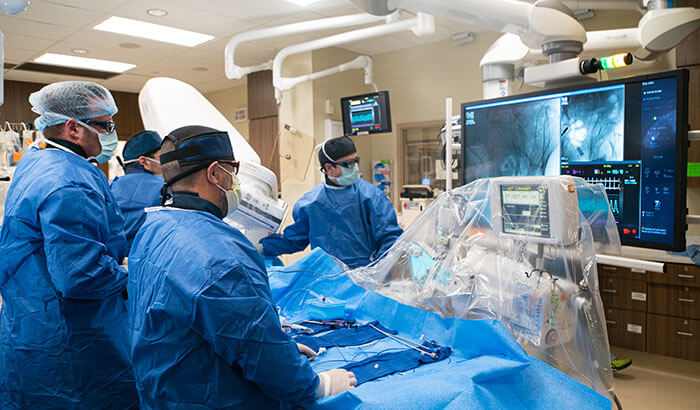UH Interventional Cardiologist Publishes Important New Findings on Women’s Heart Health in the New England Journal of Medicine
May 01, 2024
Innovations in Cardiovascular Medicine & Surgery | June 2024
Patients with a small annulus in the aortic valve of the heart – the ring-like base of the valve that supports its leaflets – face challenges when undergoing transcatheter aortic valve replacement (TAVR). These patients, many of them women, are at greater risk for a host of poor outcomes, including impaired valve hemodynamics, high gradients, prosthesis–patient mismatch, reduced exercise capacity and impaired prosthesis durability.
 Guillherme Attizzani, MD
Guillherme Attizzani, MDUnfortunately, few randomized clinical trials have compared the different TAVR prostheses with these patients and issues in mind – until now. Results of the SMART trial, comparing self-expanding and balloon-expandable TAVR valves in patients with an annulus area of 430 mm2 or less, were recently published in the New England Journal of Medicine.
Study co-author and steering committee member Guilherme Attizzani, MD, Interventional Director of University Hospitals (UH) Harrington Heart & Vascular Institute’s Valve and Structural Heart Disease Center, says this new head-to-head study – the first in the U.S. and larger and more comprehensive than its European counterparts – fulfills an important role. Dr. Attizzani also holds the Alexander and Marianna McAfee Endowed Chair in Innovative Cardiovascular Intervention.
“We’re addressing the very important topic of which valve is better for patients with smaller annuli, and that includes 90% of women undergoing TAVR. So that's a big deal,” he says. “It's important to understand which valve provides a larger orifice and better performance overall.”
Study Details
The SMART trial enrolled 716 patients at 83 treatment sites in 13 countries. The average age of patients in the study was 80, and 87% of participants were women. Study sponsor Medtronic says the SMART trial is the largest, randomized, controlled TAVR trial to primarily enroll women.
These patients with severe, symptomatic aortic stenosis were randomly assigned to undergo TAVR with either a self-expanding supraannular valve or a balloon-expandable valve. Study investigators followed each patient for 12 months, monitoring outcomes such as death, disabling stroke, rehospitalization for heart failure and a composite endpoint measuring bioprosthetic-valve dysfunction. Each patient will also continue to be followed for five years.
 Guilherme Attizzani, MD and colleagues during TAVR procedure.
Guilherme Attizzani, MD and colleagues during TAVR procedure.Results and What They Mean
Results from the SMART trial show that among patients with severe aortic stenosis and a small aortic annulus who underwent TAVR, a self-expanding supraannular valve was non-inferior to a balloon-expandable valve with respect to clinical outcomes. At the same time, the self-expanding valve and was superior with respect to bioprosthetic-valve dysfunction through 12 months. The self-expanding valve was also superior to the balloon-expandable valve in mean gradient, effective orifice area, hemodynamic structural valve dysfunction, and bioprosthetic-valve dysfunction in women through 12 months, as well as moderate or severe prosthesis–patient mismatch at 30 days.
Dr. Attizzani says TAVR clinical practice at UH Harrington Heart & Vascular Institute will not change as a result of these new findings, as the Institute is already using the self-expanding valve for its patients with a small annulus. Nevertheless, he says, the study is likely to have wide impact.
“We have been believers in the self-expandable valve technology for a long time,” he says. “But we hope these new findings will encourage others who have not typically used these devices to take a second look.”
Contributing Expert:
Guilherme Attizzani, MD
Interventional Director, Valve and Structural Heart Disease Center
University Hospitals Harrington Heart & Vascular Institute
Alexander and Marianna McAfee Endowed Chair in Innovative Cardiovascular Intervention
University Hospitals
Professor of Medicine, Case Western Reserve University School of Medicine


